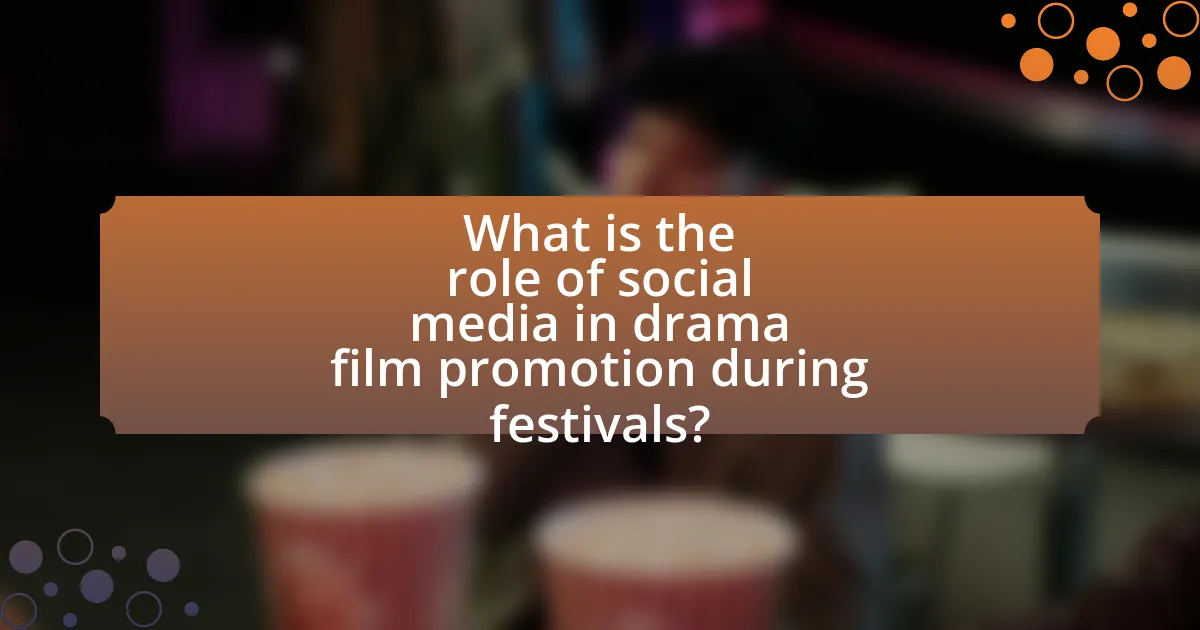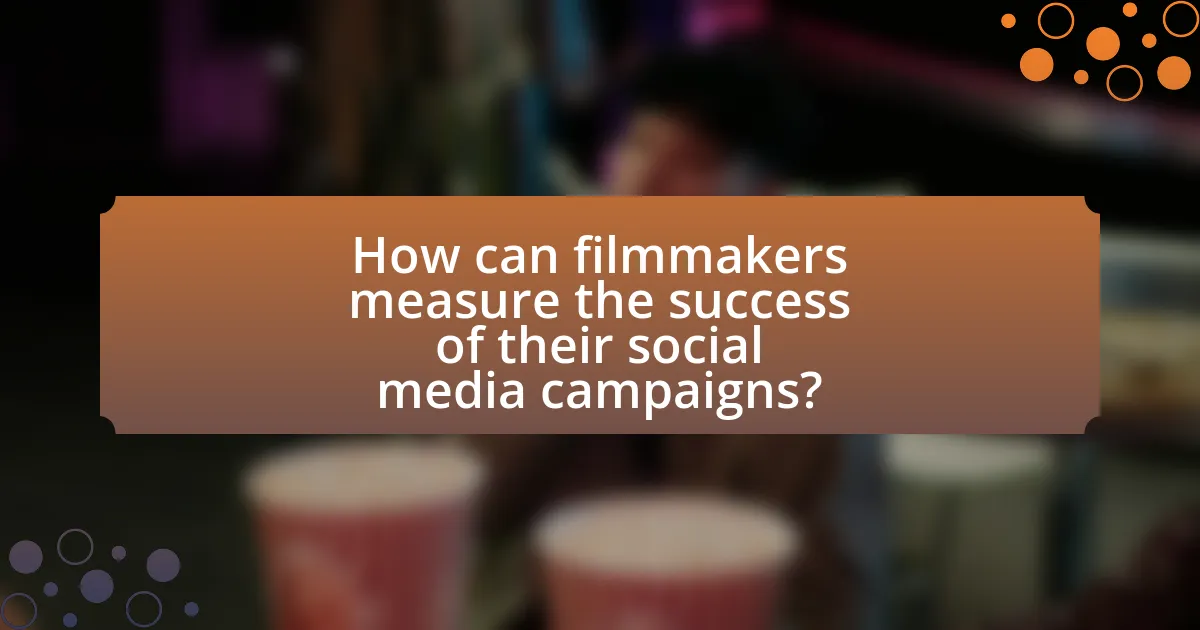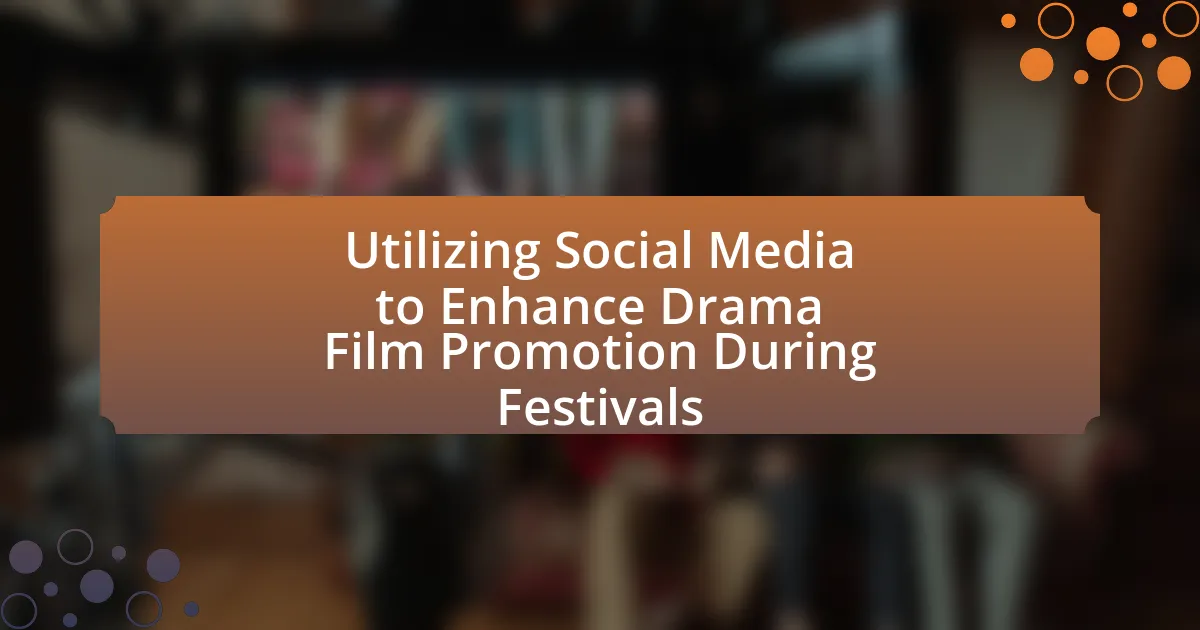The article focuses on the role of social media in enhancing drama film promotion during festivals. It highlights how platforms like Instagram, Facebook, and Twitter facilitate direct engagement between filmmakers and audiences, leading to increased visibility and attendance. Key findings indicate that effective social media strategies can significantly boost audience turnout and foster community interaction. The article also explores demographic interactions with promotional content, the importance of tailored marketing strategies, and best practices for filmmakers to optimize their social media presence. Additionally, it discusses the impact of influencers and the metrics filmmakers should track to measure campaign success.

What is the role of social media in drama film promotion during festivals?
Social media plays a crucial role in drama film promotion during festivals by providing a platform for filmmakers to engage directly with audiences and generate buzz. It enables real-time updates, behind-the-scenes content, and interactive discussions, which can significantly enhance audience interest and attendance. For instance, a study by the University of Southern California found that films with active social media campaigns saw a 30% increase in festival attendance compared to those without. This demonstrates that effective social media strategies can amplify visibility and foster community engagement, ultimately contributing to a film’s success at festivals.
How does social media influence audience engagement for drama films?
Social media significantly enhances audience engagement for drama films by facilitating direct interaction between filmmakers and viewers. Platforms like Instagram, Twitter, and Facebook allow filmmakers to share behind-the-scenes content, trailers, and promotional materials, which can generate buzz and anticipation. For instance, a study by the University of Southern California found that films with active social media campaigns saw a 20% increase in audience turnout compared to those without. This engagement is further amplified through user-generated content, where audiences share their own experiences and reactions, creating a community around the film. Additionally, targeted advertising on social media enables filmmakers to reach specific demographics, increasing the likelihood of engagement from potential viewers.
What platforms are most effective for promoting drama films on social media?
The most effective platforms for promoting drama films on social media are Instagram, Facebook, and Twitter. Instagram’s visual-centric approach allows filmmakers to share compelling imagery and trailers, engaging audiences effectively; it boasts over 1 billion monthly active users, making it ideal for reaching diverse demographics. Facebook facilitates targeted advertising and community building through groups and event pages, with 2.9 billion monthly active users, enabling filmmakers to connect with specific audiences. Twitter serves as a real-time platform for updates and interactions, with 450 million monthly active users, allowing filmmakers to engage in conversations and trends relevant to their films. These platforms collectively enhance visibility and audience engagement for drama films during festivals.
How do different demographics interact with drama film promotions on social media?
Different demographics interact with drama film promotions on social media in distinct ways, influenced by factors such as age, gender, and cultural background. For instance, younger audiences, particularly those aged 18-34, tend to engage more actively with promotional content through likes, shares, and comments, often utilizing platforms like Instagram and TikTok, where visual storytelling is prominent. In contrast, older demographics, such as those aged 35 and above, may prefer Facebook for information sharing and community discussions, leading to a different engagement pattern characterized by more passive consumption rather than active interaction.
Research indicates that women are more likely to engage with emotional content, which is prevalent in drama films, while men may focus on action-oriented promotions. A study by the Pew Research Center found that 69% of adults aged 18-29 use Instagram, compared to only 40% of those aged 50 and older, highlighting the generational divide in platform preference and interaction style. Additionally, cultural background can influence the types of narratives that resonate, with diverse audiences responding to promotions that reflect their experiences and values. This demographic variability underscores the necessity for tailored marketing strategies that consider these differences to enhance engagement and effectiveness in drama film promotions on social media.
Why is social media essential for drama film festivals?
Social media is essential for drama film festivals because it amplifies visibility and engagement with audiences. By leveraging platforms like Facebook, Twitter, and Instagram, festivals can reach a broader audience, promote screenings, and generate buzz around films. For instance, a study by the University of Southern California found that 70% of festival attendees learn about events through social media channels, highlighting its effectiveness in audience outreach. Additionally, social media facilitates real-time interaction, allowing filmmakers and audiences to connect, share experiences, and foster community, which is crucial for the success of any festival.
What unique opportunities does social media provide for filmmakers at festivals?
Social media provides filmmakers at festivals with unique opportunities for audience engagement, real-time feedback, and enhanced visibility. Filmmakers can leverage platforms like Instagram, Twitter, and Facebook to share behind-the-scenes content, trailers, and live updates, which can significantly increase audience interest and attendance. According to a study by the University of Southern California, 70% of festival-goers reported discovering films through social media promotions, highlighting its effectiveness in reaching potential viewers. Additionally, social media allows filmmakers to connect directly with audiences and industry professionals, fostering networking opportunities that can lead to future collaborations or distribution deals.
How can social media enhance the visibility of independent drama films?
Social media enhances the visibility of independent drama films by providing a platform for targeted marketing and audience engagement. Independent filmmakers can utilize platforms like Instagram, Twitter, and Facebook to share trailers, behind-the-scenes content, and engage directly with potential viewers, creating a community around their films. According to a study by the University of Southern California, films that actively engage audiences on social media can increase their visibility by up to 50%, as these platforms facilitate word-of-mouth promotion and allow for real-time feedback. This direct interaction not only builds anticipation but also fosters a loyal fan base, which is crucial for the success of independent films in a competitive market.

What strategies can filmmakers use to leverage social media for promotion?
Filmmakers can leverage social media for promotion by creating engaging content that resonates with their target audience. This includes behind-the-scenes footage, cast interviews, and interactive posts that encourage audience participation. For instance, a study by the Pew Research Center indicates that 69% of adults in the U.S. use social media, making it a vital platform for reaching potential viewers. Additionally, filmmakers can utilize targeted advertising on platforms like Facebook and Instagram to reach specific demographics, enhancing visibility and engagement. Collaborating with influencers who align with the film’s themes can also amplify reach, as influencers often have established trust with their followers.
How can filmmakers create engaging content for social media?
Filmmakers can create engaging content for social media by leveraging behind-the-scenes footage, interactive polls, and short clips that highlight key moments from their films. This approach not only provides audiences with exclusive insights but also fosters a sense of connection and anticipation. For instance, a study by the Pew Research Center indicates that 69% of adults in the U.S. use social media, making it a vital platform for filmmakers to reach potential viewers. Engaging content can also include user-generated content campaigns, where audiences share their experiences or reactions, further enhancing community involvement and interest in the film.
What types of content resonate most with audiences during film festivals?
Narrative-driven content resonates most with audiences during film festivals. Audiences are drawn to compelling stories that evoke emotions, showcase unique perspectives, and highlight cultural themes. For instance, films that incorporate personal journeys or social issues often generate discussions and engagement, as evidenced by the success of films like “Moonlight,” which won the Academy Award for Best Picture in 2017, largely due to its powerful narrative and representation of marginalized communities. Additionally, behind-the-scenes content, such as interviews with filmmakers and cast, enhances audience connection and interest, as seen in the promotional strategies of major festivals like Sundance and Cannes.
How can behind-the-scenes content enhance audience interest?
Behind-the-scenes content enhances audience interest by providing an authentic glimpse into the creative process and the personalities behind a film. This type of content fosters a deeper emotional connection between the audience and the filmmakers, as it reveals the effort, challenges, and teamwork involved in production. For instance, studies show that audiences are more likely to engage with content that feels personal and relatable, which behind-the-scenes footage effectively delivers. Additionally, behind-the-scenes content can create a sense of exclusivity and insider knowledge, making viewers feel like they are part of the filmmaking journey, thus increasing their investment in the film’s success.
What role do influencers play in promoting drama films on social media?
Influencers play a crucial role in promoting drama films on social media by leveraging their large followings to create buzz and engagement around the films. They generate awareness through posts, reviews, and live interactions, which can significantly increase audience interest and attendance. For instance, a study by the Digital Marketing Institute found that 49% of consumers depend on influencer recommendations when making purchase decisions, highlighting the effectiveness of influencers in shaping public perception. Additionally, influencers often share exclusive content, behind-the-scenes footage, and personal insights, which can enhance the emotional connection viewers have with the film, ultimately driving ticket sales and viewership.
How can filmmakers identify and collaborate with relevant influencers?
Filmmakers can identify and collaborate with relevant influencers by utilizing social media analytics tools to assess engagement metrics and audience demographics. These tools, such as Hootsuite or BuzzSumo, allow filmmakers to pinpoint influencers whose followers align with their target audience, ensuring a more effective promotional strategy. Additionally, filmmakers should engage with influencers by reaching out through direct messages or email, proposing collaboration ideas that highlight mutual benefits, such as co-hosting events or sharing exclusive content. Research indicates that influencer marketing can yield an ROI of up to 11 times the initial investment, demonstrating the potential effectiveness of these collaborations in enhancing film visibility during festivals.
What are the potential risks and rewards of influencer partnerships?
Influencer partnerships can yield significant rewards, such as increased brand visibility and audience engagement, while also presenting risks like potential reputational damage and misalignment with brand values. The rewards stem from influencers’ ability to reach targeted demographics effectively; for instance, a study by the Digital Marketing Institute found that 49% of consumers depend on influencer recommendations for their purchasing decisions. Conversely, risks include the possibility of influencers behaving in ways that could harm the brand’s image, as seen in cases where influencers faced backlash for controversial statements or actions, leading to negative publicity for associated brands.

How can filmmakers measure the success of their social media campaigns?
Filmmakers can measure the success of their social media campaigns by analyzing key performance indicators (KPIs) such as engagement rates, reach, and conversion metrics. Engagement rates, which include likes, shares, comments, and overall interaction with posts, provide insight into how well the content resonates with the audience. Reach indicates the total number of unique users who see the content, helping filmmakers understand their audience size. Conversion metrics, such as ticket sales or website visits generated from social media links, directly correlate social media efforts to tangible outcomes. According to a 2021 report by Hootsuite, campaigns that effectively utilize these metrics can increase audience engagement by up to 50%, demonstrating the importance of data-driven analysis in evaluating campaign success.
What metrics should filmmakers track to evaluate their social media impact?
Filmmakers should track engagement metrics, reach, follower growth, and conversion rates to evaluate their social media impact. Engagement metrics, such as likes, shares, and comments, indicate how well content resonates with the audience. Reach measures the total number of unique users who see the content, providing insight into visibility. Follower growth reflects the increasing interest in the filmmaker’s work, while conversion rates show how effectively social media efforts lead to desired actions, such as ticket sales or website visits. These metrics collectively offer a comprehensive view of a filmmaker’s social media effectiveness in promoting their films during festivals.
How can engagement rates inform future promotional strategies?
Engagement rates can inform future promotional strategies by providing insights into audience preferences and content effectiveness. High engagement rates indicate that specific types of content resonate well with the audience, allowing marketers to tailor future campaigns to align with these preferences. For instance, a study by HubSpot found that posts with higher engagement rates lead to increased brand awareness and customer loyalty, demonstrating the importance of analyzing these metrics. By leveraging engagement data, promotional strategies can be optimized to enhance reach and impact during film festivals, ensuring that marketing efforts are both efficient and effective.
What tools can filmmakers use to analyze social media performance?
Filmmakers can use tools such as Hootsuite, Sprout Social, and Google Analytics to analyze social media performance. Hootsuite allows users to track engagement metrics across multiple platforms, providing insights into audience interactions and content effectiveness. Sprout Social offers detailed analytics on post performance, audience demographics, and engagement trends, enabling filmmakers to tailor their promotional strategies. Google Analytics can track referral traffic from social media to a filmmaker’s website, helping to measure the impact of social media campaigns on overall audience reach and engagement. These tools collectively provide filmmakers with actionable data to enhance their social media strategies during film festivals.
What best practices should filmmakers follow for effective social media promotion?
Filmmakers should create engaging, consistent content tailored to their target audience for effective social media promotion. This involves sharing behind-the-scenes footage, cast interviews, and interactive posts to build a community around the film. Consistency in posting helps maintain audience interest and engagement, with studies showing that brands that post regularly see 67% more engagement than those that do not. Additionally, utilizing platform-specific features, such as Instagram Stories or Twitter polls, can enhance interaction and visibility. Engaging with followers through comments and messages fosters a sense of connection, which is crucial for building a loyal fan base.
How can filmmakers maintain a consistent brand voice across platforms?
Filmmakers can maintain a consistent brand voice across platforms by developing a clear brand identity that includes defined messaging, visual elements, and tone. This identity should be reflected uniformly in all communications, including social media posts, promotional materials, and public interactions. For instance, using the same logo, color scheme, and language style across platforms reinforces recognition and coherence. Research indicates that consistent branding can increase revenue by up to 23%, highlighting the importance of a unified approach. By regularly reviewing and updating their brand guidelines, filmmakers can ensure that all team members and collaborators adhere to the established voice, further solidifying their presence across various platforms.
What are common pitfalls to avoid in social media promotion for drama films?
Common pitfalls to avoid in social media promotion for drama films include neglecting audience engagement, failing to tailor content to specific platforms, and over-promoting without providing value. Neglecting audience engagement can lead to a lack of connection with potential viewers, as studies show that interactive posts generate 6 times more engagement than passive content. Failing to tailor content to specific platforms results in missed opportunities; for instance, visual storytelling is more effective on Instagram, while in-depth discussions thrive on Twitter. Over-promoting can alienate audiences; research indicates that 70% of users prefer brands that offer informative content over promotional messages.
